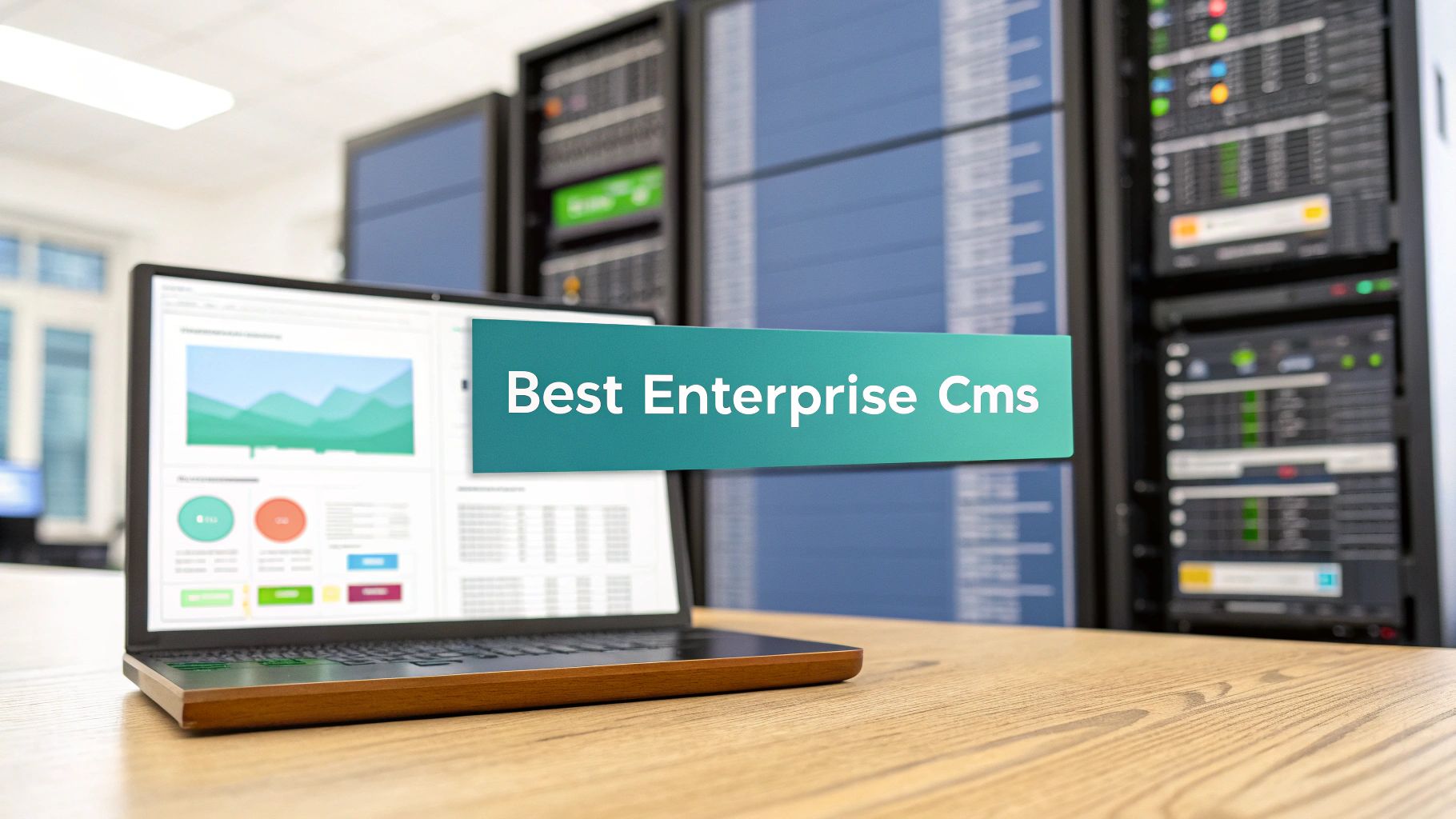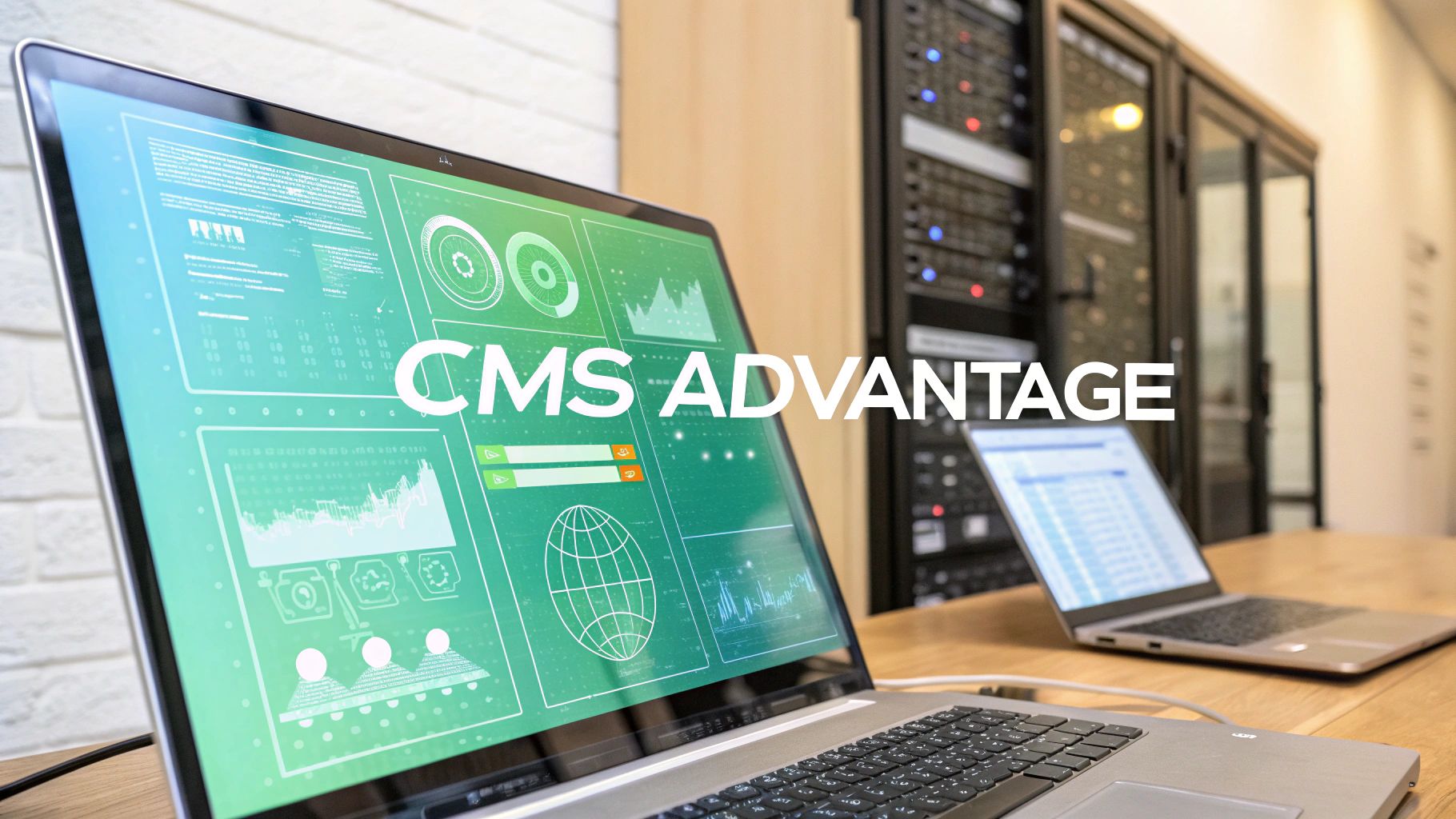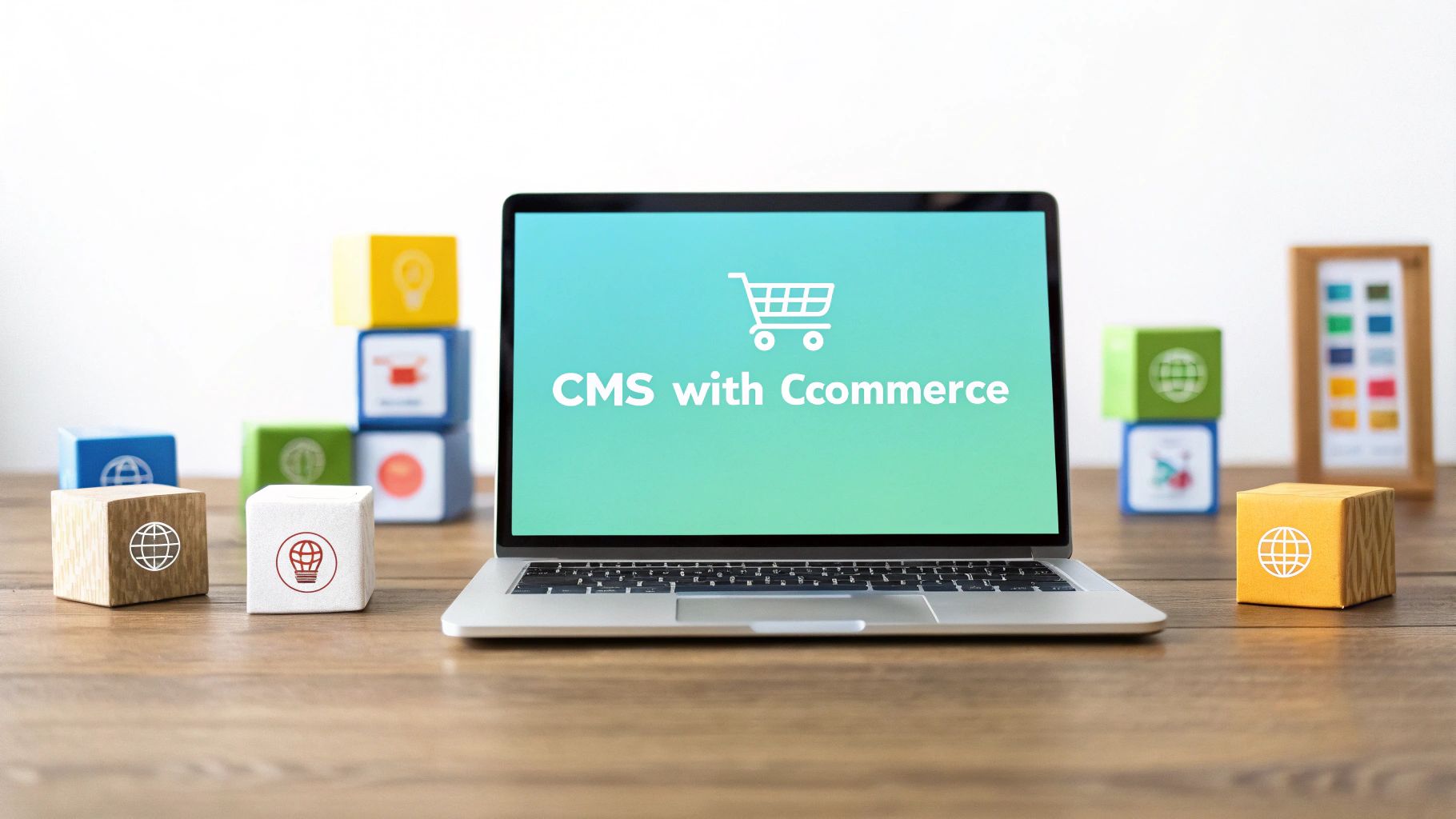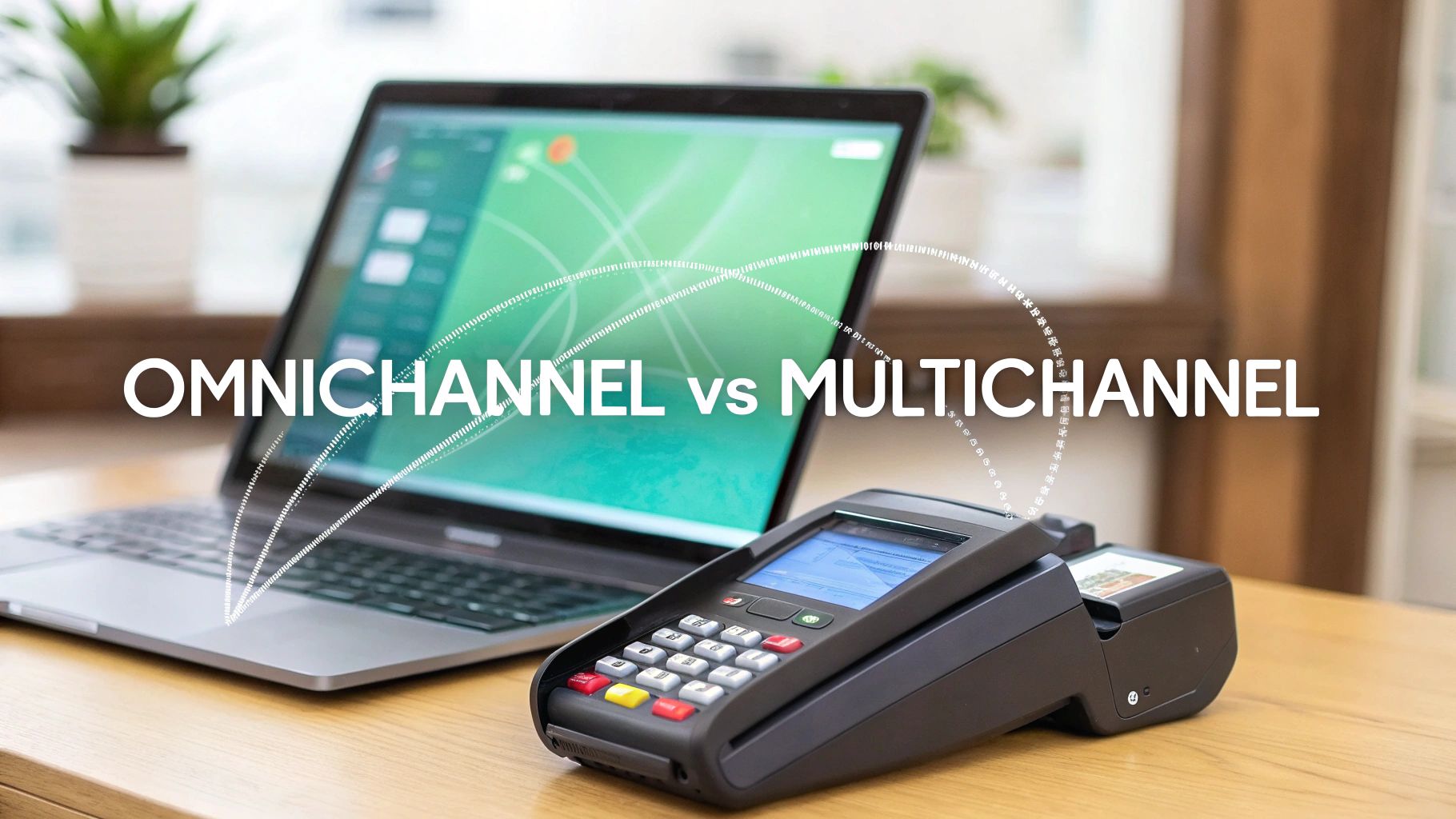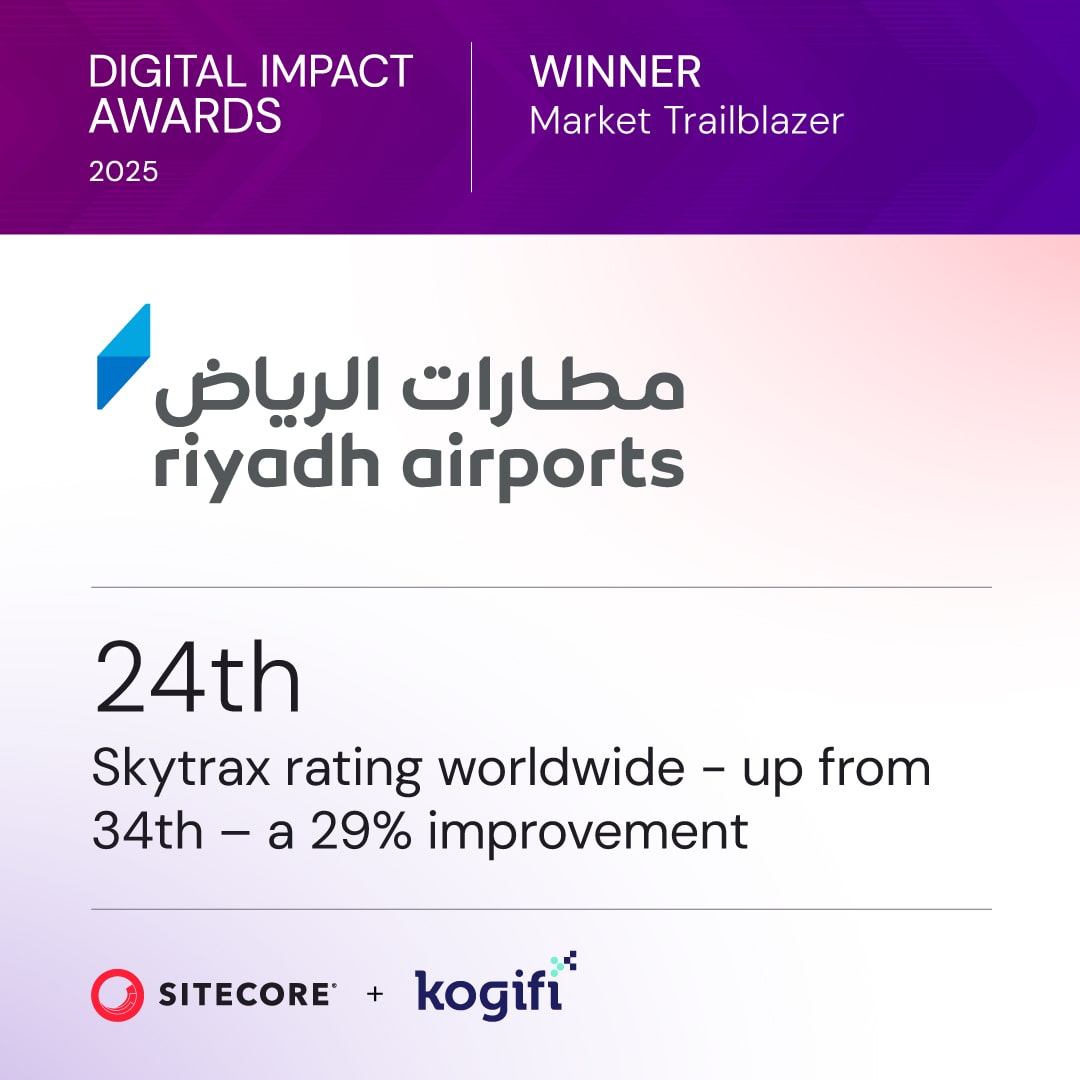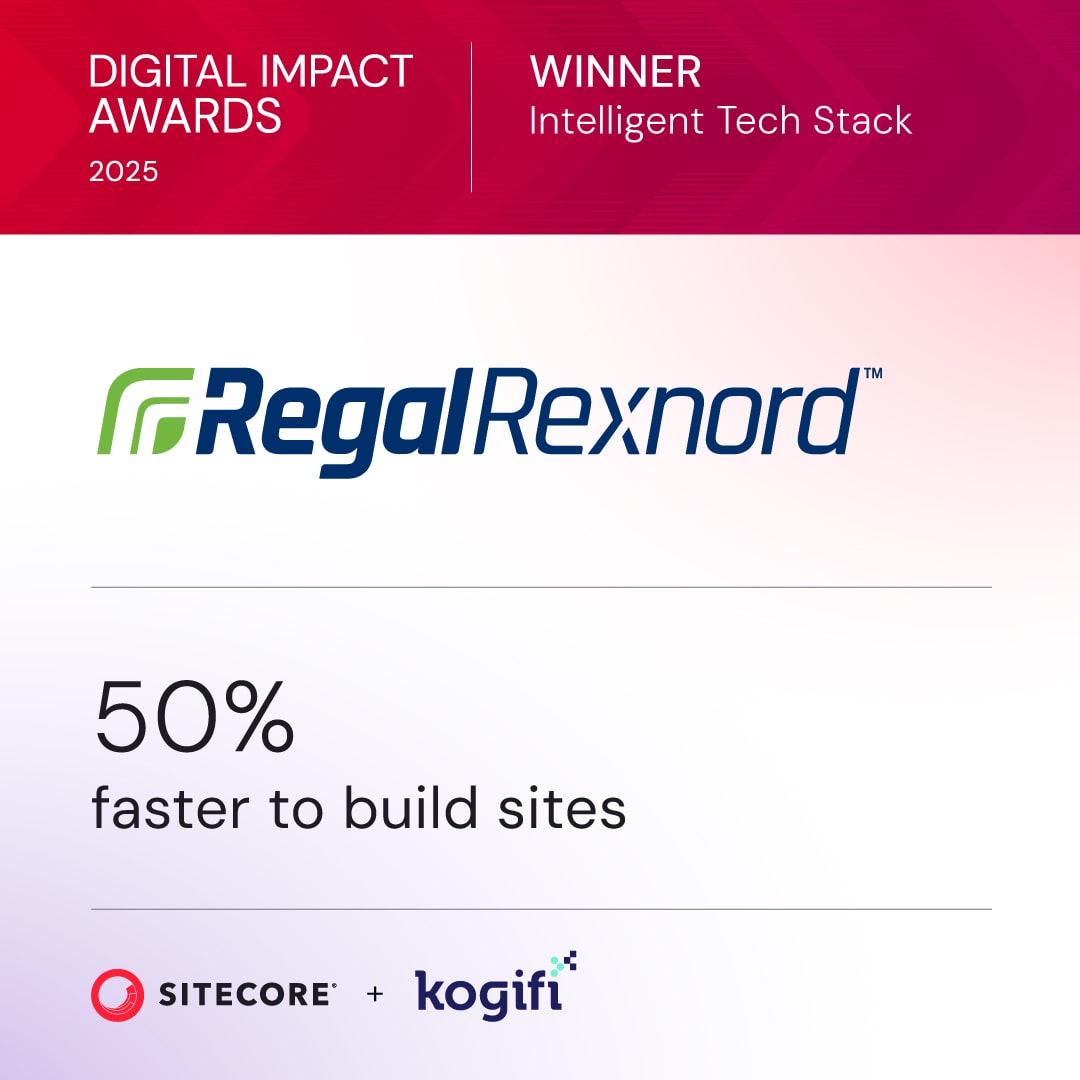Picking the right enterprise content management system is a critical strategic decision. It’s the digital foundation that dictates how you connect with customers and how your teams collaborate. This guide provides an expert view on two industry titans: Sitecore, a composable platform engineered for world-class customer experiences, and Microsoft SharePoint, the definitive leader in enterprise-wide collaboration.
The distinction between these platforms is paramount. Your choice depends on a foundational question: is your primary goal to win, retain, and understand customers, or is it to empower and connect your internal teams?
Why Your Enterprise Content Management System Matters

An Enterprise Content Management (ECM) system has evolved far beyond its origins as a digital filing cabinet. Today, a modern ECM is the central nervous system for a company's information, governing how content is created, managed, delivered, and archived. This evolution from a passive storage utility to an active, strategic business tool is fueling significant market growth.
The global ECM market is demonstrating a robust growth trajectory, underscoring the shift to cloud solutions and the urgent need for sophisticated data governance.
The primary purpose of a modern ECM is to establish a single source of truth. It dismantles information silos, ensuring every team—from marketing to legal—is operating with consistent, up-to-date, and secure information.
The true value of an ECM isn't just in storing content; it's about putting that content to work. A well-implemented system turns static documents into dynamic assets that accelerate workflows, sharpen decisions, and build stronger customer relationships.
Distinguishing Between External and Internal Focus
The fundamental difference between platforms like Sitecore and SharePoint lies in their core purpose. Sitecore's composable DXP is purpose-built for crafting personalized, omnichannel customer journeys that drive revenue. In contrast, SharePoint is architected to optimize internal collaboration, knowledge sharing, and document-centric workflows.
This guide will focus on that critical distinction. We'll analyze how each platform addresses different business challenges, providing a clear framework for your decision-making process. You can also explore the foundational benefits of enterprise content management in our related article.
Quick Guide Sitecore vs SharePoint
Before a deep dive, here’s a high-level comparison of what defines each platform and where it delivers maximum value.
Think of Sitecore as your customer-facing experience engine and SharePoint as your internal productivity powerhouse. With this framework, let's explore which is the right fit for your enterprise needs.
Mastering Customer Experience with Sitecore's Composable DXP
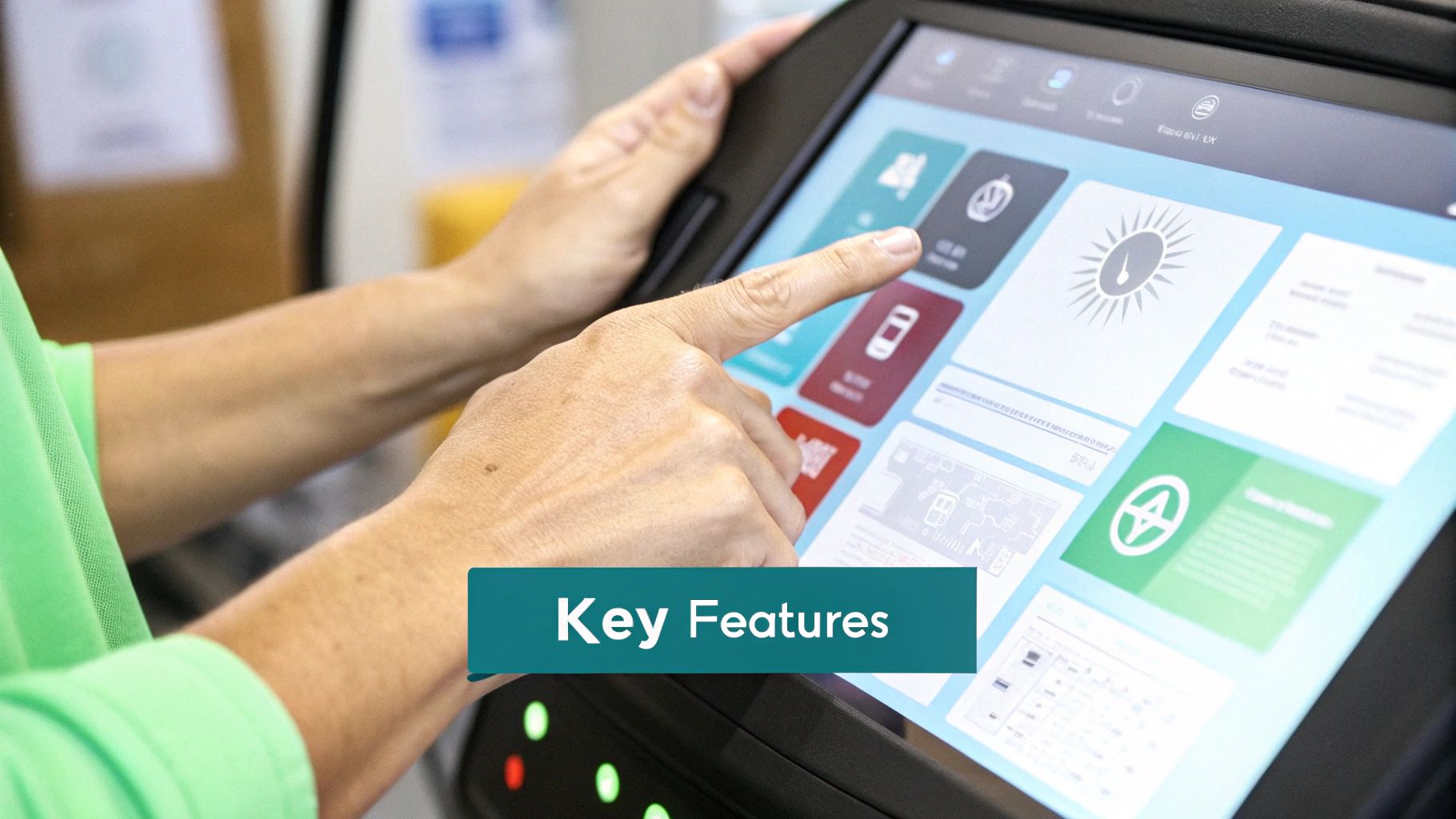
When the business imperative shifts from managing internal documents to winning customer loyalty, Sitecore emerges as a definitive choice for the best enterprise content management system. It is not merely a CMS; it is a comprehensive Digital Experience Platform (DXP) engineered to build, manage, and orchestrate highly personalized experiences across every conceivable channel.
Sitecore's modern strategy is anchored in a composable architecture—a strategic evolution from the monolithic, all-in-one systems of the past. This model empowers enterprises to assemble a "best-of-breed" digital ecosystem. Instead of being locked into a single vendor's toolkit, you can integrate preferred marketing, e-commerce, and analytics platforms. This flexibility is essential for adapting to market shifts and evolving customer expectations.
The core philosophy of Sitecore is that content is not a static asset to be stored, but a dynamic tool to be activated. Every blog post, product description, or landing page becomes an instrument for engagement, delivered with precision at the most impactful moment.
The Power Trio: Sitecore's Core Products
At the heart of Sitecore’s DXP is a trio of interconnected products that work in concert to deliver intelligent, one-to-one experiences. Each has a distinct role, but together they form a powerful engine for digital marketing and customer engagement.
Sitecore XM Cloud: This is the agile, cloud-native core of the CMS. As a SaaS solution, XM Cloud liberates marketing teams from rigid IT development cycles. It enables rapid content creation and deployment through a visual editor and a headless architecture. This means content can be published to any channel—websites, apps, IoT devices, or digital signage—without requiring a system rebuild.
Sitecore Personalize: This is the intelligence layer driving real-time personalization. It employs sophisticated decisioning models and A/B testing to tailor experiences for every visitor. By tracking user behavior and applying AI-driven logic, Sitecore Personalize can dynamically alter content, offers, and messaging on the fly, transforming a generic website visit into a unique, individualized conversation.
Sitecore CDP (Customer Data Platform): This is the foundation that makes true personalization possible. Sitecore CDP unifies customer data from every touchpoint—online and offline—into a single, persistent profile. It captures everything from website clicks and email opens to in-store purchases, creating a complete 360-degree view of the customer. This rich, unified data fuels the personalization engine with unparalleled accuracy.
From Data to Action: A Real-World Scenario
Let's imagine a global retail brand using Sitecore. A customer, Jane, is browsing for running shoes on their website but leaves without buying anything.
Data Capture: Sitecore CDP immediately logs her browsing behavior, noting her interest in a specific shoe model and size. This data is appended to her unified customer profile, which already contains her past purchase history.
Real-Time Personalization: A week later, Jane returns to the site. Sitecore Personalize recognizes her instantly. Using data from the CDP, it serves up a homepage banner featuring the exact running shoes she viewed. It even suggests a new blog post titled "Choosing the Right Running Shoe for Your Gait," demonstrating an understanding of her intent.
Omnichannel Engagement: Jane then receives a targeted email with a limited-time offer on those same shoes. When she clicks the link, the landing page is already pre-filled with her size and color preference, creating a completely frictionless path to purchase.
This is the fundamental difference in Sitecore’s approach. It moves beyond basic content management to create an intelligent, data-driven ecosystem where every piece of content serves a strategic purpose in the customer lifecycle.
The Composable Advantage
Adopting a composable architecture is not just a technical upgrade; it's a strategic business decision. For enterprises, it translates to greater agility and a future-proof technology stack. When new channels or technologies emerge, a composable DXP allows for the integration of new tools without requiring a complete system overhaul.
This approach ensures your digital experience capabilities can scale in lockstep with your business ambitions. To see how this architecture delivers at scale, check out our detailed guide on composable DXPs for scalable personalization.
For any enterprise focused on market leadership and deep customer loyalty, a platform that intelligently activates content is non-negotiable. Sitecore’s DXP is built for exactly that, making it a front-runner for any organization that measures success by the quality of its customer relationships.
Powering Internal Collaboration with Microsoft SharePoint

While platforms like Sitecore command the customer-facing digital stage, Microsoft SharePoint is the undisputed champion of the internal corporate world. For decades, it has served as the backbone for document management, team collaboration, and secure corporate intranets. It isn't built to win new customers; it's engineered to empower the employees who do.
SharePoint’s profound power stems from its deep, native integration within the Microsoft 365 ecosystem. It is best understood not as a standalone product, but as the content layer connecting everything else. A document saved in a Teams channel is stored in a SharePoint site. A file shared via OneDrive for Business leverages SharePoint’s security and versioning capabilities.
This inherent connectivity makes it the default choice for any organization heavily invested in Microsoft’s productivity suite. It unifies disparate tools into a single hub where employees can collaborate on documents, access company news, and automate routine tasks without ever leaving their familiar digital workspace.
The Cornerstone of Document Management and Governance
At its core, SharePoint is a robust document management engine. It excels at imposing order on unstructured data—the contracts, reports, policies, and project plans that are the lifeblood of any large organization. But its capabilities extend far beyond simple storage.
Advanced version control is a critical feature, enabling teams to track every modification made to a document, review previous versions, and restore them if necessary. This eliminates file naming chaos and ensures everyone is working from a single, approved version.
SharePoint also provides enterprise-grade tools for records management and compliance. Organizations can define retention policies that automatically archive or delete documents according to legal or regulatory mandates. For industries like finance, healthcare, and law, where data governance is non-negotiable, this functionality is essential.
Building a Unified Productivity Hub
SharePoint truly shines when integrated with other Microsoft 365 tools, transforming from a file repository into a dynamic productivity hub.
- Integration with Microsoft Teams: Each Microsoft Team created is backed by a corresponding SharePoint site, which handles all file storage, permissions, and content management for that Team’s collaborative activities.
- Connecting with OneDrive: While OneDrive serves as personal storage for work files, SharePoint is the repository for team and organizational content. The two are seamlessly linked, allowing users to sync SharePoint document libraries to their local machines for offline access, with all changes automatically synchronized back to the cloud.
- Automation via Power Platform: SharePoint lists and libraries serve as ideal data sources for Power Automate and Power Apps. This allows businesses to build custom workflows and applications with minimal to no code. For example, a new expense report uploaded to a SharePoint library can trigger an approval workflow, automatically routing it to the appropriate manager for review.
SharePoint's purpose is to create a single source of truth for all internal corporate knowledge. It secures unstructured data, enforces governance, and makes critical information discoverable, transforming static files into active business assets.
The demand for such systems is evident in the market's trajectory. The Enterprise Content Management (ECM) market, valued at USD 42.93 billion in 2024, is projected to reach USD 150.97 billion by 2032. Many organizations struggle with content fragmentation, a problem SharePoint is specifically designed to solve. Effective ECM implementation can drastically reduce content maintenance costs and search times, delivering a direct boost to productivity. You can explore more ECM market research insights from Fortune Business Insights.
SharePoint's Role as a Corporate Intranet
Beyond document management, SharePoint is the premier platform for building sophisticated corporate intranets. Modern communication sites and hub sites enable companies to create engaging internal portals for sharing news, distributing resources, and fostering a sense of community.
These intranets become the digital front door for employees, providing a centralized location for everything from HR policies and organizational charts to company-wide announcements. With tools like Viva Connections, this intranet experience can be integrated directly into Microsoft Teams, meeting employees where they already work.
For any organization looking to streamline internal operations, enhance security, and cultivate a connected workforce, SharePoint is a leading contender for the best enterprise content management system. You can learn more by exploring our detailed overview of SharePoint platform services. It provides the structure, security, and integration necessary to manage corporate knowledge effectively.
Head-to-Head Comparison for Enterprise Use Cases
Selecting the best enterprise content management system requires looking beyond feature lists. The decision must align a platform's core architecture with your specific business objectives. Let's place Sitecore and SharePoint in a direct, scenario-based comparison to highlight their distinct strengths.
First, let's establish some market context. This chart illustrates the market share among leading enterprise content management vendors, providing a view of the competitive landscape.
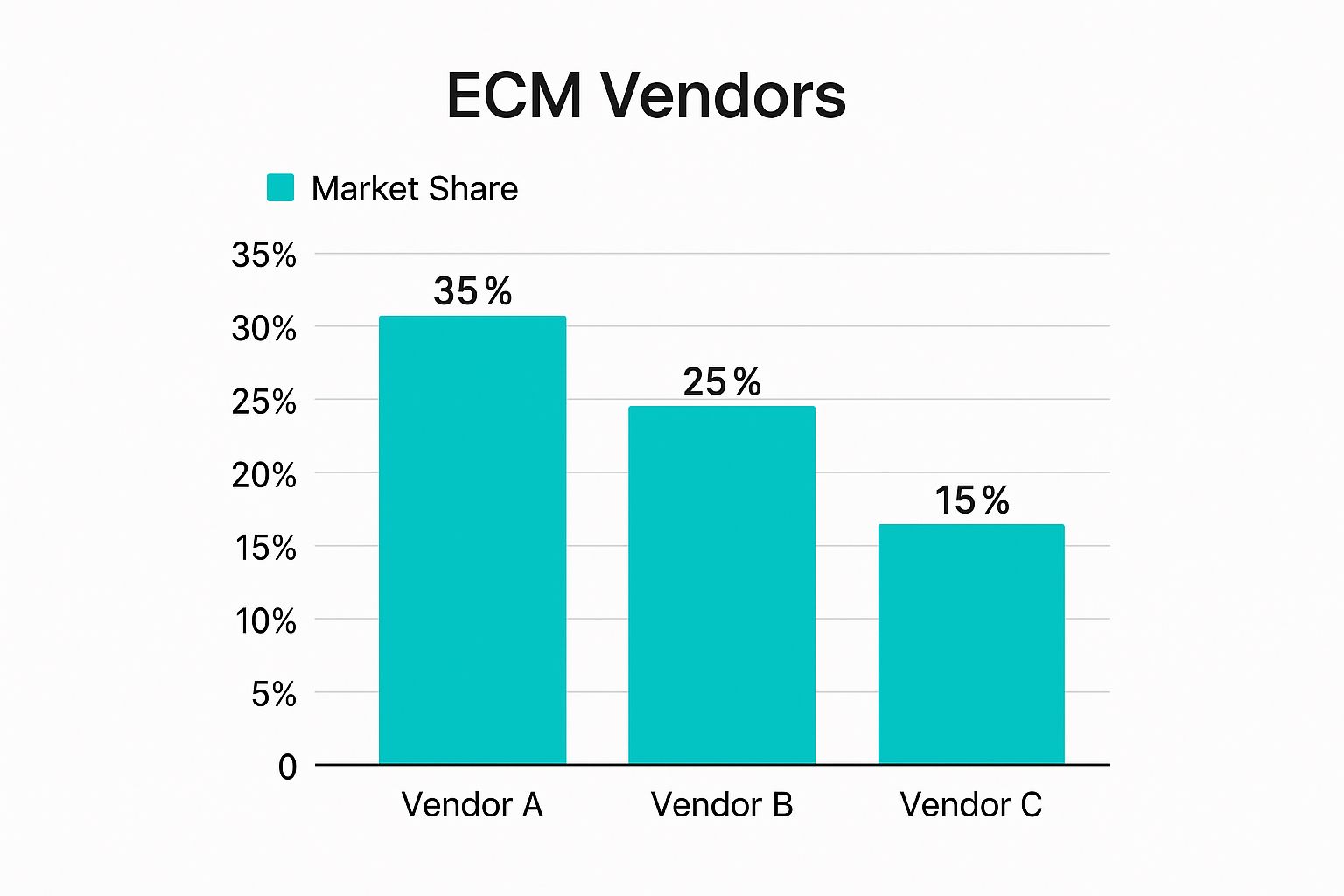
The market concentration underscores the importance of choosing a platform with a robust foundation, strong vendor support, and a clear product roadmap.
Personalization for External Marketing
When the primary objective is driving revenue through intelligent, tailored customer engagement, Sitecore is the unequivocal leader. It is a marketing machine, armed with a powerful suite of tools designed to create the individualized experiences that drive conversion and loyalty.
Sitecore's Approach:
Sitecore leverages its Customer Data Platform (CDP) and Personalize engine to make one-to-one marketing a reality at scale. It aggregates behavioral data from every touchpoint, unifies it into comprehensive customer profiles, and then uses AI to predict user intent. For a global e-commerce brand, this means displaying products to a returning visitor based on their browsing history, geographic location, and loyalty status—all in real time.
SharePoint's Approach:
SharePoint does not compete in this domain. It lacks the native capabilities for external marketing personalization because it was never engineered for that purpose. While it can store customer-related documents for internal teams, it has no functionality to track external visitor behavior or dynamically alter public-facing web content.
For a deeper look at how various systems compare, our comprehensive content management system comparison provides some extra perspective.
Key Differentiator: Sitecore's entire architecture is built around activating customer data for external marketing and sales. SharePoint's architecture is focused on securing and organizing internal corporate information. They are designed to solve fundamentally different business problems.
Process Automation for Internal Teams
Conversely, for an internal business need like streamlining the invoice approval process, SharePoint takes center stage, flexing its strength as an operational powerhouse.
SharePoint's Approach:
An accounts payable team can configure a SharePoint document library to receive all incoming invoices. The moment a new invoice is uploaded, a Power Automate workflow is triggered. The system can automatically extract key data, route it to the appropriate department head for approval based on predefined rules, and then archive the approved document with the correct retention policies. The entire process becomes automated, traceable, and secure.
Sitecore's Approach:
Sitecore lacks a native, document-centric workflow engine that can compete with SharePoint’s deep integration with the Power Platform. While it includes workflows for content publishing, it is not designed to manage operational business processes like invoice processing or employee onboarding. Attempting to use it for such tasks would require significant custom development far outside its intended purpose.
To further clarify, here is a matrix breaking down how each platform addresses common enterprise needs.
Strategic Use Case Matrix Sitecore vs SharePoint
This table maps Sitecore and SharePoint against key strategic requirements, helping align a platform’s core strengths with your specific business goals.
Ultimately, this comparison highlights that your choice depends entirely on the problem you're trying to solve. For customer-facing experiences, Sitecore leads. For internal operations, SharePoint is the clear winner.
Architecture and Scalability
An enterprise CMS must be able to scale with your organization. The architectural philosophies of Sitecore and SharePoint are fundamentally different, leading to distinct strengths in scalability and flexibility.
Sitecore's Composable Model:
Sitecore champions a composable architecture. This modern, API-first approach allows you to select best-in-class tools for each function—whether e-commerce, search, or analytics—and integrate them seamlessly. This provides incredible flexibility, enabling you to swap components as your needs evolve without overhauling the entire system. For a global enterprise managing multiple brands, this agility is a significant competitive advantage.
SharePoint's Integrated Platform:
SharePoint employs a more integrated, platform-centric approach. Its value lies in its deep, out-of-the-box connectivity to the entire Microsoft 365 ecosystem. All scaling is managed within the Microsoft Azure cloud, ensuring robust performance. The trade-off is reduced flexibility when integrating non-Microsoft tools, as the system is designed to function as a cohesive unit.
Ecosystem and Integration
No enterprise platform operates in isolation. Its ability to communicate with other critical business systems is paramount for a unified and efficient technology stack.
- Sitecore's Technology Partnerships: Sitecore’s ecosystem comprises a vast network of technology partners, creating a rich marketplace of pre-built connectors for leading CRM, ERP, and marketing automation platforms. This strategy perfectly supports its composable vision, giving you the freedom to build a truly customized digital experience stack.
- SharePoint's Microsoft 365 Connectivity: SharePoint's greatest integration strength is its native fusion with Microsoft 365. The seamless link to Teams, Outlook, OneDrive, and the Power Platform creates a powerful productivity engine out of the box. For organizations already heavily invested in the Microsoft universe, this native integration is a massive advantage, reducing friction and simplifying daily workflows.
How To Choose The Right ECM Platform
Selecting the best enterprise content management system ultimately comes down to one question: what is your primary business driver? Are you focused on acquiring and retaining customers through exceptional digital experiences? Or is your top priority to streamline internal operations and enhance team collaboration?
Your answer points directly to either Sitecore or SharePoint.
This decision should not be based on a feature-for-feature comparison. It's about aligning a major technology investment with your most critical business goals. A misaligned choice can lead to wasted investment and missed opportunities. The stakes are high, as reflected by the explosive growth in the ECM market. The enterprise content management software market reached an estimated USD 75.9 billion in 2024 and is projected to exceed USD 217.4 billion by 2033. This surge is driven by the demand for automation and support for distributed workforces. You can explore the full enterprise content management software market research from IMARC Group to understand the trends.
When to Choose Sitecore: The Customer Experience Engine
You should choose Sitecore when your business objectives are tied to external, customer-facing outcomes. If your metrics for success include conversion rates, customer lifetime value, and seamless omnichannel journeys, Sitecore’s DXP is purpose-built for you.
Clear indicators that Sitecore is the right choice include:
- Personalization at Scale: Your strategy involves delivering unique, one-to-one content to millions of users across your website, mobile apps, and email campaigns. Sitecore’s CDP and Personalize products are engineered specifically for this purpose.
- Data-Driven Marketing: You need to unify customer data from dozens of online and offline channels to build a single customer view, which you can then use for highly targeted marketing initiatives.
- Composable Architecture: Your organization requires the flexibility to select best-in-class marketing, analytics, and e-commerce tools to build a custom tech stack that can adapt to market changes.
When to Choose SharePoint: The Internal Operations Hub
Conversely, SharePoint is the clear winner when your focus is on optimizing internal processes, securing corporate knowledge, and enhancing employee productivity. If your primary goals are to eliminate operational bottlenecks, ensure regulatory compliance, and empower your teams, SharePoint is the answer.
SharePoint is the obvious choice in these scenarios:
- Document Lifecycle Management: Your business relies on structured workflows for managing sensitive documents such as contracts, invoices, or HR files, which demand strict version control and retention policies.
- Deep Microsoft 365 Integration: Your company is already heavily invested in the Microsoft ecosystem—including Teams, OneDrive, and the Power Platform—and you need a content hub that integrates seamlessly.
- Building a Corporate Intranet: Your primary objective is to create a central hub for company news, essential resources, and team collaboration to foster a more connected and informed workforce.
For many large companies, the best answer isn't "either/or" but "both/and." A hybrid strategy, where Sitecore runs the external customer experience and SharePoint handles internal collaboration, plays to the strengths of each platform without compromise.
This dual-platform approach creates a powerful, purpose-built digital ecosystem. Your marketing teams can leverage Sitecore’s sophisticated tools to engage customers, while your operational teams rely on SharePoint to work more efficiently and securely. By clearly defining your primary business driver, you can select the right platform—or combination of platforms—to ensure your investment delivers tangible ROI and fuels long-term growth.
Common Questions About Enterprise Content Systems
Investing in an enterprise content management system inevitably raises important questions. This section addresses some of the most frequent queries, focusing on the real-world differences between platforms like Sitecore and SharePoint to help guide your decision.
How Is Sitecore's Composable DXP Different from a Traditional CMS?
A traditional CMS can be compared to a pre-built house: an all-in-one system with fixed functions, primarily designed to create and manage content for a single website. While functional, its monolithic structure makes it difficult to adapt to new channels or technologies.
Sitecore’s composable DXP, in contrast, is like building with high-tech modular components. It deconstructs the monolithic model into individual, best-in-class microservices for content, personalization, customer data, and commerce. This API-first approach allows you to assemble a flexible, custom digital ecosystem. Instead of being locked into one vendor's toolkit, you can integrate preferred solutions, ensuring your tech stack evolves with your business.
The core difference is a shift in philosophy. A traditional CMS manages content for a website; a composable DXP like Sitecore orchestrates personalized experiences across all digital touchpoints, powered by a unified customer profile.
Can SharePoint Be Used for Public Websites?
Technically, yes, but it is no longer the appropriate tool for this purpose. In its earlier versions, SharePoint was often used for public-facing sites. However, Microsoft has since strategically pivoted the platform almost exclusively toward internal collaboration, document management, and corporate intranets.
Modern SharePoint is engineered to be the content and collaboration engine for Microsoft 365. It excels at creating secure team sites, managing document lifecycles with robust versioning and retention policies, and integrating seamlessly with tools like Microsoft Teams and Power Automate.
Using it for an external marketing site would mean forgoing the essential personalization, analytics, and customer data capabilities that are native to a DXP like Sitecore. For any serious customer-facing digital experience, a dedicated DXP is the superior choice.
What Are the Key Factors for Planning a Migration?
A successful ECM migration is a strategic initiative, not just a technical task of moving files. The key factors to consider are:
- Content Audit and Cleanup: Before migrating, conduct a thorough audit of your existing content to identify what is redundant, obsolete, or trivial (ROT). Archive or delete this content to ensure you only move valuable and relevant information to the new system.
- Metadata and Taxonomy Strategy: A migration is an opportunity to reset your content structure. Define a clear and consistent metadata framework for the new platform. A well-designed taxonomy is critical for discoverability, search functionality, and enabling personalization rules in a system like Sitecore.
- Integration and Dependency Mapping: Identify and document every system that connects to your current ECM, from CRMs to ERPs. Mapping these dependencies is crucial for ensuring they can be re-established or replaced within the new architecture, a particularly important step in a composable environment.
At Kogifi, we specialize in implementing and optimizing the best enterprise content management system for your unique business goals. Our experts in Sitecore and SharePoint are ready to guide your digital transformation. Learn more about how we can help you build a powerful digital foundation.

















